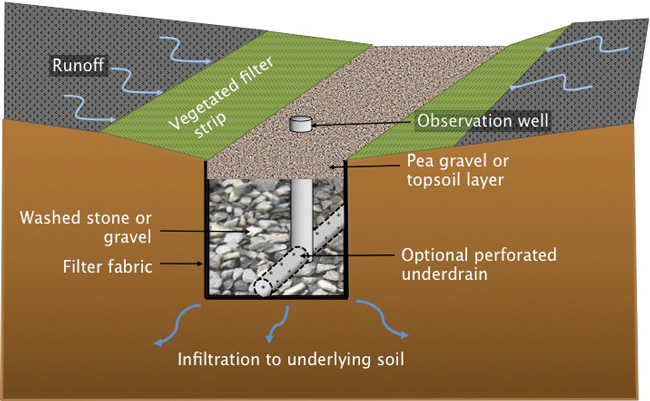
Protecting our environment, one stormwater practice at a time.
Infiltration Practices
Overview
Infiltration practices are stone-filled facilities that are designed to receive and store stormwater runoff and allow it to slowly infiltrate into the underlying soil. Allowing stormwater to filter back into the ground close to where the rain falls is one of the more beneficial ways to treat stormwater runoff. The primary pollutant removal mechanism of this practice is filtering the stormwater through the soil. Infiltration practices have the greatest runoff reduction capability of any stormwater practice and are suitable for use in residential and other urban areas where measured soil permeability rates exceed one-half inch per hour.
How Infiltration Practices Work
 Stormwater runoff should first pass through one or more pretreatment mechanisms such as a vegetated filter strip, grass channel or sediment trap. Pretreatment slows the water down and removes sediment and organic matter before it reaches the facility. Stormwater flows into the facility through a layer of vegetated topsoil, pea gravel or stone. In some practices stormwater is piped underground and directly into the stone. It is then stored in the void space between the stones and infiltrates through the surrounding filter fabric layer and into the underlying soil. An underdrain may be required if soil permeability rates are one-half inch to one inch per hour. As the stormwater penetrates the underlying soil, chemical and physical adsorption processes remove pollutants.
Stormwater runoff should first pass through one or more pretreatment mechanisms such as a vegetated filter strip, grass channel or sediment trap. Pretreatment slows the water down and removes sediment and organic matter before it reaches the facility. Stormwater flows into the facility through a layer of vegetated topsoil, pea gravel or stone. In some practices stormwater is piped underground and directly into the stone. It is then stored in the void space between the stones and infiltrates through the surrounding filter fabric layer and into the underlying soil. An underdrain may be required if soil permeability rates are one-half inch to one inch per hour. As the stormwater penetrates the underlying soil, chemical and physical adsorption processes remove pollutants.

Soil Permeability and Infiltration Rates
The permeability rate of soil is the rate at which water moves down through the soil. It is usually measured in inches per hour. Infiltration is the rate at which water enters the soil and is also measured in inches per hour. Infiltration is similar to permeability except that it takes into account the surface conditions of the soil. Permeability and infiltration rates affect the rate at which water can soak into the soil. Applying water too fast can lead to sealing of the soil surface which decreases infiltration rates. It can also lead to ponding, which increases runoff, which causes erosion. Soil texture and structure are usually the dominant soil properties affecting infiltration and permeability. Soils that are high in clay content tend to have a slower permeability rate. Soils that are high in sand content tend to have a faster permeability rate.
Soil structure refers to the cracks and pores between soil aggregates which allows for the movement of air and water through the soil, therefore improving permeability. Fine-textured soils (soils with high clay content) contain more total pore space than coarse-textured soils (such as sandy loam and sand); however, the pore spaces are smaller. Because of this, water moves more slowly through a fine textured soil. Organic matter improves soil structure, which has beneficial effects on both permeability and infiltration. In contrast, salts cause soil particles to disperse and clog pores, which has a negative effect on soil structure and slows infiltration and permeability rates.
How to Maintain and Infiltration Practice
- Mow pretreatment devices such as vegetated filter strips as necessary and properly dispose of the clippings
- Inspect pretreatment devices and the facility at least twice per year and remove sediment, trash and organic debris as needed
- Remove any plants and trees from the facility as needed
- Replace pea gravel and topsoil when clogged
Troubleshooting Standing Water
If standing water is observed in the observation well 48 hours after a ½ inch rain storm, then the facility is likely clogged and consultation with a professional is recommended. Any clogging must be addressed to maintain facility function.
- If standing water is present on the surface, but not observed in the underdrain, the surface layer is clogged and in need of replacement
- If standing water is present on the surface and in the underdrain, the underdrain is clogged and needs to be flushed
FairFacts
- Infiltration practices replenish water and eliminate the need for costly structures and improvements to convey runoff from the developed site.
- Infiltration practices may not be constructed on fill material or slopes steeper than 15 percent.
- Infiltration practices reduce the temperature of urban streams because they encourage infiltration of stormwater into the ground and promote groundwater recharge. Because stormwater travels underground to the stream, it has little opportunity to increase in temperature.
- A stormwater hot spot is an area where land use or activities may generate contaminated runoff with increased pollutant concentrations. Infiltration practices should never receive runoff from hot spots due to the potential for groundwater contamination, unless the stormwater has already been treated.
The information in this fact sheet is general in nature and is not intended to determine maintenance responsibility.
For more information, contact:
Department of Public Works and Environmental Services, Maintenance and Stormwater Management Division
10635 West Drive, Fairfax, VA 22030
703-877-2800, TTY 711
ContactMSMD@fairfaxcounty.gov

